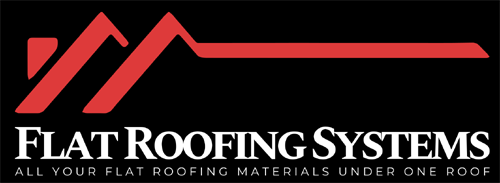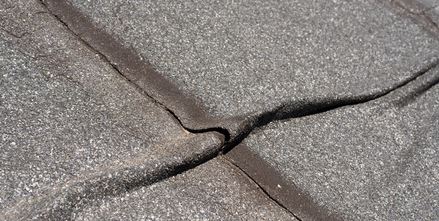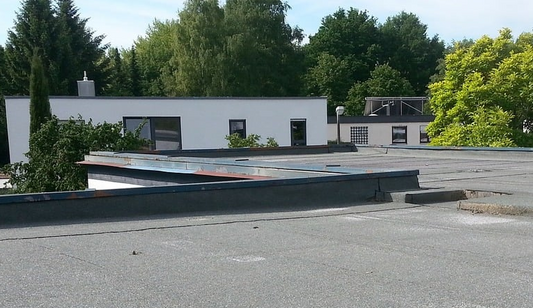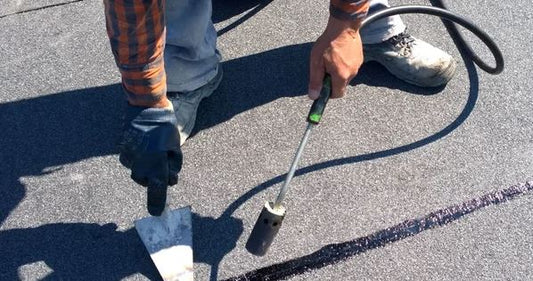EPDM roofs can last 50+ years with proper care. Inspect your roof bi-annually, focusing on seams, edges, and drainage systems. Clean using gentle, non-petroleum cleaners and soft brushes to prevent membrane damage. Address ponding water immediately and repair small tears before they expand. Remove debris regularly and trim overhanging branches to prevent punctures. Balance DIY maintenance with professional inspections every 2-3 years to catch hidden issues. The following strategies will maximize your roof's protection potential.
Key Points
- Conduct bi-annual inspections focusing on seams, flashings, and drainage systems to catch problems early.
- Clean your EPDM roof regularly with non-abrasive, manufacturer-approved cleaners to prevent chemical damage.
- Remove debris promptly to prevent moisture accumulation and potential membrane damage.
- Apply protective coatings to combat UV radiation effects and extend the roof's functional lifespan.
- Document all maintenance activities in a log to track deterioration patterns and inform future repairs.
Understanding EPDM Roofing Material Properties
EPDM roofing, the backbone of many commercial and residential flat roof systems, offers exceptional durability that sets it apart from conventional roofing materials.
Your EPDM membrane delivers outstanding weather resistance against extreme conditions while withstanding persistent UV radiation that deteriorates other materials.
This synthetic rubber compound's impressive lifespan exceeds 50 years when you maintain it properly through regular inspections and timely repairs.
The material's inherent resistance to abrasion, punctures, and ozone means you'll face fewer maintenance issues compared to traditional options.
EPDM's unique properties make it a cost-effective roofing solution over time, particularly because of its thermal management capabilities.
The smooth, black surface efficiently regulates temperature fluctuations, absorbing heat during winter months and reflecting it during summer.
This dual functionality enhances your building's energy efficiency while protecting its structural integrity.
Seasonal Inspection Protocols for Maximum Protection
Your EPDM roof covering requires strategic seasonal inspections to maintain its protective capabilities throughout the year.
During spring assessments, focus on winter damage repair, membrane integrity verification, and clearing drainage systems of accumulated debris.
Your fall protocol should emphasize seam reinforcement, flashings inspection, and weatherproofing vulnerable areas before winter conditions challenge your roofing system.
Spring Inspection Checklist
Four critical steps form the foundation of effective spring maintenance for EPDM roofing systems.
- First, conduct a thorough examination for signs of wear, including cracks, blisters, and tears that compromise membrane integrity. Pay particular attention to seams and flashings around penetrations where separation often begins.
- Second, clear gutters and guarantee proper drainage throughout your roofing system to prevent water pooling that deteriorates the EPDM membrane over time.
- Third, clean the surface using only a soft-bristle brush and appropriate cleaners that won't damage the rubber material.
- Finally, document condition details in your maintenance log, recording observations about potential problem areas. This systematic approach enables you to track deterioration patterns and determine when to consult a roofing professional for specialized repairs beyond routine maintenance.
Autumn Weatherproofing Protocol
As temperatures begin to drop and autumn leaves fall, preparing your EPDM roof for winter becomes vital to prevent costly damage.
Your fall weatherproofing routine should include regular inspections focused on identifying signs of damage before winter weather exacerbates them.
- Conduct thorough bi-annual inspections, with fall being a vital time to assess your EPDM roof's condition.
- Clear gutters and drainage systems of leaves and debris to prevent water backup and pooling water issues.
- Examine all seams and flashing points where separation might allow moisture infiltration.
- Check for areas of standing water after rainfall, which can indicate drainage problems.
- Document your findings in a maintenance log to track deterioration patterns over time.
This systematic approach helps identify minor issues before they develop into costly repairs during winter months.
Proper Cleaning Techniques to Prevent Membrane Damage
You'll need to use only gentle cleaning solutions specifically formulated for EPDM roofs to maintain your membrane's integrity and prevent premature degradation.
Always clean with soft-bristle brushes or mops that won't scratch or abrade the rubber surface, removing debris thoroughly but carefully.
Avoid petroleum-based products and harsh chemicals that can break down the rubber compounds, and rinse completely with low-pressure water to prevent residue buildup that could compromise your roof's performance.
Gentle Cleaning Solutions
Maintaining the integrity of your EPDM roof depends largely on choosing the right cleaning approach. When cleaning your EPDM roof, use only gentle cleaning solutions that won't compromise the membrane's structural integrity or accelerate wear.
- Select a mild non-abrasive cleaner specifically formulated for EPDM surfaces.
- Dilute the cleaner according to manufacturer instructions for best effectiveness.
- Apply the solution with a soft-bristled brush, using gentle circular motions.
- Rinse thoroughly with a low-pressure hose to prevent build-up of residual chemicals.
- Perform regular maintenance cleaning to extend the life of your roofing membrane.
Soft-Bristle Equipment Only
Selecting the right tools stands as a critical factor in preventing damage to your EPDM roof membrane during routine maintenance. Always use soft-bristle brooms or mops when cleaning your EPDM roof to gently remove debris without scratching the surface.
These gentler tools protect the membrane's integrity while effectively clearing away dirt and leaves that could otherwise retain moisture and lead to leaks.
For stubborn stains, apply an EPDM-specific cleaner or mild detergent solution, avoiding harsh chemicals that can compromise the roof's protective qualities. After cleaning, thoroughly rinse with a low-pressure hose to remove all residue.
Implement regular inspection and cleaning schedules using only soft-bristle equipment to guarantee your EPDM roof maintains its longevity.
This preventative approach helps identify potential issues before they escalate into costly repairs.
Prevent Chemical Damage
Chemical exposure represents one of the greatest threats to your EPDM roof's longevity and performance. Proper care of your roofing membranes demands attention to cleaning products that won't compromise structural integrity.
- Always select non-abrasive cleaners specifically formulated for EPDM roofing materials.
- Dilute your cleaning solution according to manufacturer specifications for effective yet gentle cleaning.
- Never use harsh chemicals or abrasive petroleum-based products that deteriorate rubber compounds.
- Implement regular cleaning with a soft-bristle brush to maintain surface integrity.
- Thoroughly rinse with low-pressure water to prevent residue buildup that can damage membranes.
Consistent roof maintenance using appropriate cleaning techniques prevents premature aging and extends service life.
Remember that even mild-appearing household cleaners can contain components destructive to EPDM, so verify product compatibility before application to guarantee maximum protection of your roofing investment.
Identifying and Addressing Early Signs of Wear
While EPDM roofing systems are known for their durability, they'll eventually show signs of deterioration that require prompt attention.
Conduct regular inspections at least twice yearly to detect early signs of wear like cracks, blisters, or tears in the EPDM membrane.
Biannual inspections catch cracks, blisters, and tears early—before small EPDM membrane issues become costly problems.
Focus on seams, edges, and flashings around roof penetrations—these vulnerable areas often develop leaks first.
Watch for ponding water, which indicates drainage issues and must be resolved within 48 hours to prevent premature deterioration.
Maintain a consistent cleaning routine to remove debris that traps moisture and accelerates damage.
This simple practice greatly extends your roof's lifespan.
Always document issues in a roof inspection log to track conditions over time and inform necessary maintenance actions, creating a valuable history of your roofing system's performance.
Effective Leak Detection and Repair Strategies
Even the most vigilant maintenance routines can't prevent all EPDM roof leaks. To maintain these durable roofing materials, you'll need a systematic approach to detection and repair:
- Inspect your EPDM roof quarterly for cracks, blisters, or water pooling—these early warning signs help prevent extensive damage.
- Clean affected areas thoroughly before applying an EPDM patch for minor repairs, ensuring proper adhesion.
- Address seam separations immediately, as these common entry points allow water seepage that compromises your roof's integrity.
- For large damages, cut out the affected section completely and install a reinforced patch rather than covering it.
- Consult a professional when you encounter complex issues—proper repairs require specialized knowledge and quality materials.
Don't delay addressing leaks; quick action preserves your roof's lifespan and prevents costly structural damage.

Managing Environmental Factors Affecting EPDM Durability
Although EPDM roofing systems offer exceptional durability, their longevity depends largely on how you manage environmental challenges. UV radiation presents a major threat to your roof's integrity; apply a protective coating to enhance the membrane's natural resistance and prevent premature degradation.
EPDM roofs may be tough, but their survival hinges on how well you combat environmental threats like UV radiation.
Conduct thorough inspections after extreme weather events to identify potential damage. Remove debris regularly to prevent accumulation that traps moisture and compromises your roofing system. Verify your drainage systems operate efficiently—clear gutters and downspouts to prevent standing water that weakens the membrane.
Don't overlook nearby trees; trim overhanging branches to minimize physical damage and reduce debris that could clog drainage pathways.
These proactive maintenance tips will considerably extend your EPDM roof's lifespan by addressing environmental factors before they cause serious problems.
Rounding Up
By implementing these maintenance practices, you'll greatly extend your EPDM roof's lifespan. Don't wait for leaks to appear—schedule regular inspections, clean properly, and address damage promptly. Whether you're handling maintenance yourself or hiring professionals, being proactive is key. Remember that environmental factors require specific adaptations. With proper care, your EPDM roofing system will deliver decades of reliable performance and protection.




